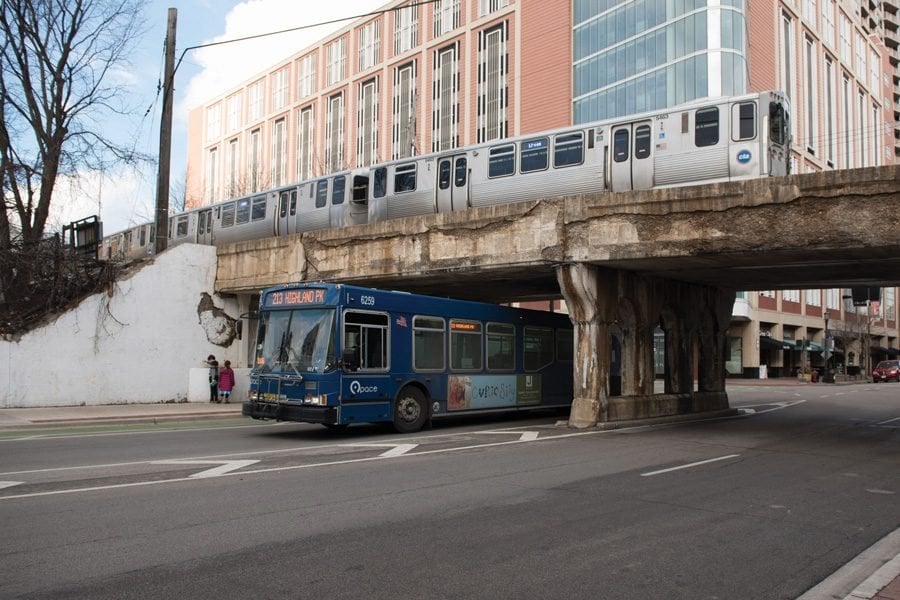Students and staff voice transportation safety concerns as the University prepares for Fall Quarter
Daily file photo by Allie Goulding
A Pace bus passes under the CTA Purple Line.
July 21, 2020
As students and staff prepare to return to campus in the fall, a question arises: How will students safely get to and from campus?
Currently, the intercampus shuttles are operating on temporary schedules and under capacity restrictions, limiting 15 riders to each bus, promoting social distancing and requiring drivers and passengers to wear masks.
In June, shuttle services departing from the Ryan Field and Ward stops ran more frequently. The intercampus shuttle is not to be used for commuting, but instead to “facilitate movement of students for classes and faculty and staff for meetings on each campus,” Transportation Services Manager Paul Merkey said in an email. Merkey said this policy has been in place since the route’s inception.
Services like the Campus Loop, the Evanston Loop and the Chicago Express will resume in the fall when students return to campus.
Merkey said Transportation Services has been watching ridership on a daily basis, and plans to implement normal shuttle operations for Fall Quarter.
But many faculty members, as well as graduate and postdoctoral students, do not live in the Evanston area, and rely on other forms of transportation.
Before the pandemic, Jake VanBelzen, a fourth-year graduate student who lives in Rogers Park, said he took the Chicago Transit Authority “L” trains to commute to campus, an option with which he no longer feels safe. He said more people have begun using the train again, but there’s no enforcement of mask-wearing or social distancing.
“You’re sitting now in train cars on the L with people not wearing masks,” VanBelzen said. “It’s a confined space and there’s really no air circulation, so it’s a great way for you to breathe the same air as someone else, even if you are wearing a mask.”
VanBelzen also acknowledged there are people who live further from campus than he does, making what he called a “lack of safe commute options” even more prominent.
Students and staff have suggested the University add more stops and increase the frequency of runs to help minimize contact.
VanBelzen, along with several other community members, have also proposed the University expand the Safe Rideservices, which currently runs 7 p.m. to 3 a.m. during the academic year and only provides services in its coverage area. Dropping or extending these parameters could provide more NU constituents access to safe transportation.
VanBelzen said he was frustrated with how the University has failed to take action around transportation. He said the administration might be slow to take action because of the pandemic’s financial impact.
“It feels like they’re valuing their finances over their constituents’ safety, over our lives,” he said. “There’s a monetary value on our safety, and the cost of dealing with this issue exceeds that value.”
Merkey said the full impact of the pandemic on financials isn’t fully known yet. In the meantime, he said Transportation Services will serve the campus community as best as possible with current resources.
Teri Odom, the chemistry department chair, also takes the L train to get to and from home. Odom’s husband is immunocompromised, so she said she has to be hyper-careful about exposure to the virus. Currently, she has been using KN95 masks to protect her from the virus instead of cloth or surgical masks on the train.
While expanding transportation options provides greater access, Odom said it will not address the root of the problem. For example, buses will face the same recirculated-air problem as trains, and Safe Rides aren’t necessarily safer.
“I feel like there’s a lot of anxiety for a lot of real reasons right now,” Odom said. “But the administration, they’re not just administration, they’re composed of people, and they’re working overtime to try to make the best decisions for their community.”
Email: [email protected]
Twitter: @delaneygnelson
Related Stories:
— Have questions or concerns about returning to campus? Let us know.
— NU researchers develop wearable device that helps monitor COVID-19 symptoms
— Northwestern to follow Chicago’s Emergency Travel Order


